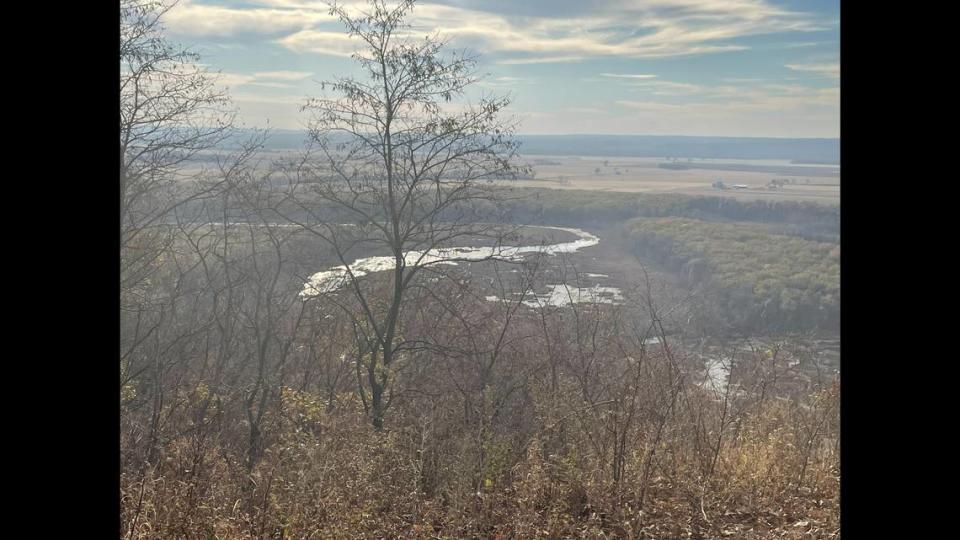For Southern Illinois and the climate, Shawnee National Park is the ‘next logical step’
Imagine standing atop a limestone bluff, a cool breeze blowing in your face as you stare at the forested valley far below.
Imagine getting in your car and driving 30 minutes to the south where you find yourself in the middle of a cypress swamp that closely resembles the bayous of Louisiana.
Then, get back in your and drive about 45 minutes to the west. There, you’ll find yourself at the base of a towering limestone bluff, just a few miles from the Mississippi River. Keep your eyes open because you’ll be surrounded by colorful wildflowers and migrating cottonmouths, copperheads and rattlesnakes as well as another dozen species of non-venomous snakes.
Where is this magical place?
Florida? Texas? California?
Nah, it’s close to home. Really, really close.
Get out your Illinois road map. See the vast green space at the bottom of the map – The Shawnee National Forest.
The places you have visited in this imaginary trip are Garden of the Gods, the Grantsburg swamp and Inspiration Point/Larue-Pine Hills.
Garden of the Gods is considered to be the most photographed spot in Illinois. Larue-Pine Hills is the home of the world-famous Snake Road, the road shut down twice a year to allow snakes to migrate to and from their hibernation dens.

These are just a few of the amazing natural areas Southern Illinois has to offer, as well as the impetus for a growing movement to re-designate the Shawnee as America’s 64th national park – The Shawnee National Park and Climate Preserve.
The movement spawned the formation of the Shawnee Park and Climate Alliance, a group working to build public support for the park. Re-designation requires an act of Congress and would result in the management of the Shawnee being transferred to the U.S. Forest Service, within the Department of Agriculture, to the National Park Service, an agency administered by the U.S. Department of the Interior.
The move makes sense on every level.
Southern Illinois is reeling economically. Coal mining, once the backbone of the region, is disappearing. With the focus on renewable energy, those jobs aren’t coming back. The 11 counties that make up the Shawnee region are among the poorest in the state with childhood poverty and unemployment figures well above state and national averages.
The population of the southernmost counties has been plummeting for decades.
Creating a national park would bring tourists from throughout the United States to Southern Illinois and give the area’s economy a much-needed jolt. That’s not simply speculation, national parks have a proven track record.
Academic studies have shown national parks bring jobs and wage increases. Real-life experience proves those studies are accurate.
The New River Gorge, located in West Virginia, is the nation’s newest national park. It was designated in 2020. Visitation increased 37 percent in the first year. Calls to local officials indicate people are moving into the region in unprecedented numbers. Established businesses are thriving and new businesses are being established.
Since there are only 63 national parks, the Shawnee becomes an instant destination for outdoor enthusiasts across the country. And, Southern Illinois is uniquely located to benefit from the additional tourism opportunities presented by national parks.
The region is within a seven-hour drive of Chicago, St. Louis, Kansas City, Louisville, Memphis, Nashville, Columbus, Indianapolis, Cincinnati and Atlanta. The population of those 10 metropolitan areas make up nearly 10 percent of the United States’ population.
National parks generate revenue -- $23.9 billion in 2022, according to National Park Service numbers. Illinois, with no national parks, is losing out on considerable revenue.
With no national parks, Illinois was the beneficiary of just $9.9 million in revenue from spending at National Park Service sites. Indiana, with just one national park, Indiana Dunes, received $135 million; Kentucky, home of Mammoth Cave, received $114 million.
Jobs?
Illinois has 131 jobs related to National Park Service sites. Indiana has 2,010 and Kentucky 1,690.
The Shawnee checks all the required boxes for consideration to be a national park – nationally significant natural, cultural or recreational resources. The aforementioned Garden of the Gods was featured on the Illinois quarter. Places like Rim Rock, Pounds Hollow, Lusk Creek Canyon and Little Grand Canyon draw visitors who are drawn to wild places.
The 290,000-acre Shawnee contains seven areas deemed so pristine they have been designated Wilderness Areas. Those areas cover about 30,000 acres.
Additionally, the Cherokee Trail of Tears winds its way through the Shawnee. Sand Hill was once a stop on the Underground Railroad. And, Millstone Bluff was home to Mississippian and Woodland peoples long before Europeans stepped foot in North America.
The other requirements for national park status are that the area be a feasible addition to the national park system. Since the land is already owned by the federal government, the switch is relatively easy. The final consideration is that the area would benefit by direct National Park Service Management.
Since recent studies show that the moister eastern deciduous forests are among the most efficient at sequestering carbon, the timing is perfect. The National Forest Services manages for the production of board feet of lumber. The National Park Service manages for the preservation of the amazing aforementioned natural areas.
The Shawnee National Forest was established in 1939 as a way to bring Southern Illinois out of the Great Depression. As one area tourism board member put it, re-designating the forest as a national park is “the next logical step.”
It is just that.
LES WINKELER is the president of the Shawnee Park and Climate Alliance.
